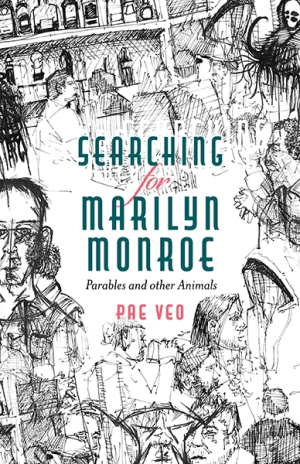
Searching for Marilyn Monroe
Parables and Other Animals
Writing is often poetic in this short story collection that weaves between allegories and clear stories.
In Searching for Marilyn Monroe, Pae Veo prods at the accepted conventions and perceptions of modern society through a series of short tales.
Divided into three sections—Stories, Parables, and Animals—the collection traces overarching themes of the meaning of creation, self-imposed and forced isolation, and the authenticity of being human.
The longest tale is also the opening one. It focuses on Wallace, an English professor turned military English tutor to non-native speakers in Puerto Rico. Dated segments from the late 1950s to the 1960s cover brief episodes of Wallace’s time in the military and the years after he leaves. He is an aspiring novelist so taken with his main character that it affects his personality. His struggles to be published and his attachment to the idea of Marilyn Monroe—representative of some bygone era that has been lost in Wallace’s own time—drive the narrative to its end.
Increasingly shorter stories follow this and grow abstract, abandoning individual characters for more universal introspection. At the intersection of this transition aptly stands “The Railway,” a snapshot of a woman traveling along parallel rail lines to reach the point on the horizon where they intersect. Yet no matter how far she walks, the lines never touch where she presently is. What has come before—for her and in the reading of the collection—and what comes after are linked, though at first it may not seem obvious how.
Literary references abound, particularly in the opening story and in the closing segments. Wallace visits the grave of Flannery O’Connor for guidance, which falls a little flat, as his idolization of her has not been sufficiently established prior. Somewhat less jarring are the T. S. Eliot footnotes and an entire meditation on Eliot’s J. Alfred Prufrock, which acts as another indictment of the modern human condition.
Writing is poetic at times, but it can also sometimes get lost in awkward syntax and confusing word choices. One episode, “Fifty Three,” features an author interacting with a nameless character he has created. It’s a fourth-wall-breaking exercise that strikes a discordant and too-obvious note. Other stories, such as “The Poplar,” have beautiful allegorical imagery that is lessened by endings that explain their own symbolism. Yet this does not distract from the overall purpose or power of the collection.
Searching for Marilyn Monroe hangs disparate parts of stories together via thematic threads, and there is much to digest here for those weary of the daily grind.
Reviewed by
Meagan Logsdon
Disclosure: This article is not an endorsement, but a review. The publisher of this book provided free copies of the book and paid a small fee to have their book reviewed by a professional reviewer. Foreword Reviews and Clarion Reviews make no guarantee that the publisher will receive a positive review. Foreword Magazine, Inc. is disclosing this in accordance with the Federal Trade Commission’s 16 CFR, Part 255.
